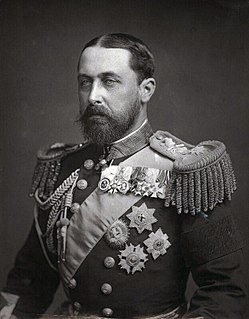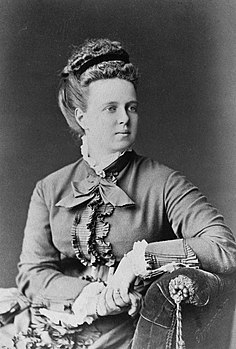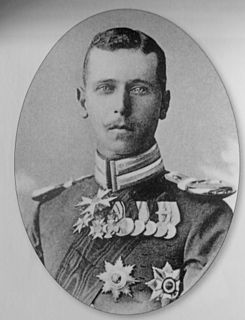
Prince Albert of Saxe-Coburg and Gotha was the consort of Queen Victoria from their marriage on 10 February 1840 until his death in 1861.

Alfred was the sovereign duke of Saxe-Coburg and Gotha from 1893 to 1900. He was the second son and fourth child of Queen Victoria and Prince Albert. He was known as the Duke of Edinburgh from 1866 until he succeeded his paternal uncle Ernest II as the reigning Duke of Saxe-Coburg and Gotha in the German Empire.

Saxe-Coburg and Gotha, or Saxe-Coburg-Gotha, was an Ernestine, Thuringian duchy ruled by a branch of the House of Wettin, consisting of territories in the present-day states of Thuringia and Bavaria in Germany. It lasted from 1826 to 1918. In November 1918, Charles Edward, Duke of Saxe-Coburg and Gotha, was forced to abdicate. In 1920, the northern part of the duchy was merged with six other Thuringian free states to form the Free State of Thuringia: Saxe-Weimar-Eisenach, Saxe-Altenburg and Saxe-Meiningen, Schwarzburg-Rudolstadt and Schwarzburg-Sondershausen, as well as the People's State of Reuss. The southern part of the duchy, as southernmost of the Thuringian states, was the only one which, after a referendum, became part of the Free State of Bavaria.

Charles Edward, Duke of Saxe-Coburg and Gotha was the last sovereign duke of Saxe-Coburg and Gotha, from 30 July 1900 until 1918. A male-line grandson of Queen Victoria and Prince Albert, he was also until 1919 a Prince of the United Kingdom and from birth held the British titles of Duke of Albany, Earl of Clarence and Baron Arklow.

Grand Duchess Maria Alexandrovna of Russia was the fifth child and only surviving daughter of Emperor Alexander II of Russia and Princess Marie of Hesse and by Rhine; she was Duchess of Edinburgh and later Duchess of Saxe-Coburg and Gotha as the wife of Alfred, Duke of Saxe-Coburg and Gotha. She was the younger sister of Alexander III of Russia and the paternal aunt of Russia's last emperor, Nicholas II.

The House of Wettin is a dynasty of German counts, dukes, prince-electors and kings that once ruled territories in the present-day German states of Saxony, Saxony-Anhalt and Thuringia. The dynasty is one of the oldest in Europe, and its origins can be traced back to the town of Wettin, Saxony-Anhalt. The Wettins gradually rose to power within the Holy Roman Empire. Members of the family became the rulers of several medieval states, starting with the Saxon Eastern March in 1030. Other states they gained were Meissen in 1089, Thuringia in 1263, and Saxony in 1423. These areas cover large parts of Central Germany as a cultural area of Germany.

Alfred, Hereditary Prince of Saxe-Coburg and Gotha, was the son and heir apparent of Alfred, Duke of Saxe-Coburg and Gotha. He died aged 24 under circumstances still not entirely clear. He was a first cousin of Kaiser Wilhelm II of Germany, King George V of the United Kingdom and Tsar Nicholas II of Russia.

Coburg is a town located on the Itz river in the Upper Franconia region of Bavaria, Germany. Long part of one of the Thuringian states of the Wettin line, it joined Bavaria by popular vote only in 1920. Until the revolution of 1918, it was one of the capitals of the Duchy of Saxe-Coburg and Gotha and the Duchy of Saxe-Coburg-Saalfeld. Through successful dynastic policies, the ruling princely family married into several of the royal families of Europe, most notably in the person of Prince Albert, who married Queen Victoria in 1840. As a result of these close links with the royal houses of Europe in the late 19th and early 20th centuries, Coburg was frequently visited by the crowned heads of Europe and their families.

Princess Sibylla of Saxe-Coburg and Gotha was a member of the Swedish royal family and the mother of the current King of Sweden, Carl XVI Gustaf.

The House of Saxe-Coburg and Gotha is a European Royal House. It takes its name from its oldest domain, the Ernestine duchy of Saxe-Coburg and Gotha, but its members later sat on the thrones of the United Kingdom, Belgium, Portugal, Bulgaria, and Mexico.

Reinhardsbrunn in Friedrichroda near Gotha, in the German state of Thuringia, is the site of a formerly prominent Benedictine abbey, the house monastery of the Ludovingian Landgraves of Thuringia abbey extant between 1085 and 1525. Later used as an administrative seat by the Ernestine dukes of Saxony, the premises were turned into a castle and park erected by the Dukes of Saxe-Coburg and Gotha from 1827.

Stutensee is a town in northern Karlsruhe district in Baden-Württemberg, Germany.

Augustus, Duke of Saxe-Gotha-Altenburg, was a Duke of Saxe-Gotha-Altenburg, and the author of one of the first modern novels to treat of homoerotic love. He was the maternal grandfather of Prince Albert, consort of Queen Victoria.

Karoline Amalie of Hesse-Kassel, was a German princess and member of the House of Hesse-Kassel by birth, and Duchess of Saxe-Gotha-Altenburg by marriage.

Duchess Marie of Württemberg was a daughter of Duke Alexander of Württemberg and Antoinette of Saxe-Coburg-Saalfeld. She was Duchess of Saxe-Coburg and Gotha from 1832 to 1844 as the second wife of Duke Ernest I. As such, she was the stepmother of Prince Albert, consort of Queen Victoria.

Schloss Rosenau, called in English The Rosenau or Rosenau Palace, is a former castle, converted into a ducal country house, near the town of Rödental, formerly in Saxe-Coburg, now lying in Bavaria, Germany.

Elisabethenburg Palace is a Baroque palace located on the northwestern edge of Meiningen in Germany. Until 1918 it was the residence of the Dukes of Saxe-Meiningen. The castle now houses the Meininger Museum as well as the Max Reger archives, the Thuringian State Archives, the Max Reger music school, the Johannes Brahms concert hall, a restaurant, the tower Cafe, and the ceremonial rooms of the Meinigen City Council and Registry Office.

Ehrenburg Palace is a palace in Coburg, Franconia, Germany. It served as the main Coburg residence for the ruling princes from the 1540s until 1918. The palace's exterior today mostly reflects Gothic Revival style.

Callenberg Castle is a castle on a wooded hill in Beiersdorf, an Ortsteil of Coburg, 6 kilometres (3.7 mi) from the town centre. It was a hunting lodge and summer residence and has long been the principal residence of the House of Saxe-Coburg and Gotha. It is currently owned by Andreas, Prince of Saxe-Coburg and Gotha who created the Ducal Saxe-Coburg and Gotha House Order. A large and architecturally important family chapel is contained within.

Friedenstein Palace is an early Baroque palace built in the mid-17th century by Ernest I, Duke of Saxe-Gotha at Gotha, Thuringia, Germany. In Germany, Friedenstein was one of the largest palaces of its time and one of the first Baroque palaces ever built. Friedenstein served as the main seat of the Dukes of Saxe-Gotha and later as one of the residences of the Dukes of Saxe-Coburg and Gotha, closely linked with the Royal Family of Great Britain through the marriage of Queen Victoria and Prince Albert. The final two ruling Dukes were both princes of the United Kingdom.




















